Note that the products discussed on our site are independently selected by our editors. Your purchases through our recommendations may earn us a commission at no extra cost to you.
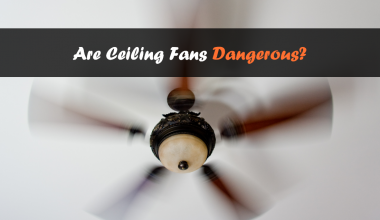
Ceiling fans prove to be a lifesaver in both summer and winter with their ability to bring comfort and save electricity bills at the same time. Apart from that, they have many other benefits that make them a must-have in a modern home. They look gorgeous when matched with the overall décor of the room and work great when operated correctly and maintained regularly.
However, the inherent nature of the ceiling fan to be spinning wildly hanging down from the ceiling makes a lot of its users question its safety. Are ceiling fans safe? Or dangerous?
If you are one of those users being skeptic about ceiling fan safety, hold tight as we are going to explore the topic in detail. We are going to find out the answer to many of the questions related to ceiling fan safety, and that will hopefully clear all your doubts.
Can Ceiling Fans Fall and Kill?
If you don’t have a lot of prior experience with ceiling fans, and then see one spinning wildly hanging down from the ceiling, one of the first concerns you inherently tend to have is, “will it fall off?” And “what happens if it does? Will it kill me?”

You are not alone, all of us had this concern when we saw a ceiling fan for the first time.
But the good news is, the answer is generally in the negative!
Let me explain.
Modern ceiling fans are designed and manufactured while strictly keeping safety concerns in mind, especially if it’s coming from a reputable brand. So, ceiling fans are generally very safe, unless you do something very stupid like jumping from below a running ceiling fan.
Furthermore, ceiling fan falls are very rare if installed and maintained properly. Injuries from a falling ceiling fan can sometimes be fatal, but it happens very rarely and mostly due to “ignorance and negligence”. We have answered this question before in a more detailed manner before. See it here: Can ceiling fans fall and kill?
Can Ceiling Fans Explode?
Before we answer this question, we need to understand what is meant by an “explosion”. It’s the sudden outburst of extreme levels of pressure built-up inside a contained chamber. The Oxford Languages dictionary defines it as, “a violent and destructive shattering or blowing apart of something, as is caused by a bomb.” Or otherwise as “a sudden outburst of something such as noise, light, or violent emotion, especially anger.” The point to note is that an explosion needs a build-up of pressure for it to occur. And fortunately, there’s nothing in a ceiling fan that builds up pressure in a contained chamber. So, you get the answer already.
Furthermore, unless you are talking about a ceiling fan entirely made of fragile materials (I don’t know of any) such as plastic, glass, or any other non-metallic material for that matter, you can rest assured that your ceiling fan has almost zero chances of exploding. A standard ceiling fan hangs from the ceiling by using a metallic downrod (metal tube) that securely attaches to the (again) metallic body of the fan. And inside the motor housing, there are only some copper wires, PCBs, and capacitors, none of which is dangerously explosive. Then we have the blades, each of which is attached to the body using no less than at least three bolts. So, there’s nothing to explode here either. And of course, if you didn’t know already, ceiling fans don’t have Uranium or Plutonium inside them! You’d hear “Open up!” at your door along with violent kicks if you did.
The only thing that can explode in a ceiling fan is the bulbs if you are using higher-than-recommended wattage incandescent bulbs or otherwise any glass-covered bulbs. But even if they do, such explosions are almost never dangerous. Furthermore, such bulbs can explode regardless of where they are installed, inside a fan or outside. So, ceiling fans are very safe as far as explosions are concerned. Still, if you want to be extra careful, use non-glass bulbs such as LEDs and you will be very safe.
Is Sleeping with a Ceiling Fan Dangerous?
Sleeping with a ceiling fan is perfectly safe. If you are being anxious about it, it’s only because you don’t have much experience with ceiling fans. However, the same can be (mostly) mildly dangerous if you have health conditions. The fan won’t fall on you, but if you have it running at high speed, the “windchill effect” might worsen your fever, cold, cough, allergies, etc.
“Fans don’t pose serious risks during the night, but for some people, they might lead to mildly irritating symptoms.”
Healthline Media, Inc
Generally speaking, sleeping with a fan running at normal speeds is perfectly fine. I do it all the time and never had any problems. If anything, it makes me have a better sleep under the comfortable breeze. In fact, it’s a must-have for me to have a good night’s sleep. I can’t imagine my night without my fan.
So, sleep with your fan running at a comfortable speed without worrying much. But if you have health conditions, you might want to keep it running at low speed or find a different way altogether to stay cool.
Are Ceiling Fans Safe for Infants?
A running ceiling fan is just as safe for infants as it is for everyone else as long as you take the necessary precautions. In fact, ceiling fans can be beneficial for them in many ways such as providing them with continually refreshing air and reducing sweat-related issues. Apart from that, ceiling fans can even have medical benefits. A study done in 2008 found that ceiling fans can help reduce SIDS in infants. Healthline puts it as:
“In one 2008 article published in the Archives of Pediatric Adolescent Medicine, researchers found fan use during sleep was associated with a 72 percent reduction in SIDS risk.”
Healthline Media, Inc
However, keep note that you must not put the fan to operate at high speeds in a baby’s room. That might make it difficult for the baby to breathe or cause him/her to get a fever and other types of such illnesses. Rather put it on low speed to reap its benefits in your infant’s room.
Are Ceiling Fans Safe with Bunk Beds?
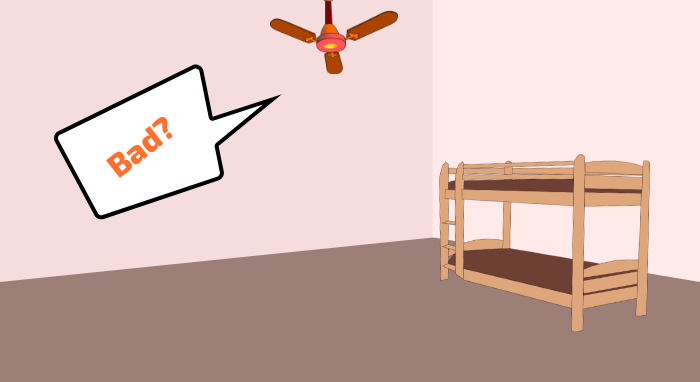
Though it might not seem a good idea to install ceiling fans with bunk beds around, but the reality is that they can be very safely used if you follow proper guidelines when installing them. If you are concerned about the safety hazards of ceiling fans used in conjunction with bunk beds, I should remind you that you should perhaps be more concerned about the bed itself as it is much riskier for your children than the fan above.
According to the Nationwide Children’s Hospital, “… an average of 36,000 bunk bed-related injuries occur every year to children in the United States.” Needless to say, only a minute percentage of that figure occurs due to ceiling fans. The same source states, proving our point, “Most bunk bed-related injuries occur from falls while sleeping or playing.”
Lara McKenzie, one of the researchers involved in the study, advised, among other things, the positioning of the bed away from any ceiling fans in order to ensure a safe experience for your kids. ABC News indirectly quoted her as saying,
“By following these tips and the instructions that come with bunk beds, they can be used safely, even with the high numbers of childhood injuries found in the study.”
Lara McKenzie
Check this guide from NCH for a full list of precautions that you need to take when using bunk beds.
So, in conclusion, ceiling fans can certainly be used safely with bunk beds as long as you take the necessary precautions. You should, as we have said, position the bed away from the fan and ensure that the fan is beyond the reach of your kids. You should also teach them not to try and reach for it, and tell them of the dangers of doing so.
Finally, if your circumstances are truly not welcoming for a ceiling fan, you can always opt for a covered ceiling fan if you need to.
Is a Wobbling Ceiling Fan Dangerous?
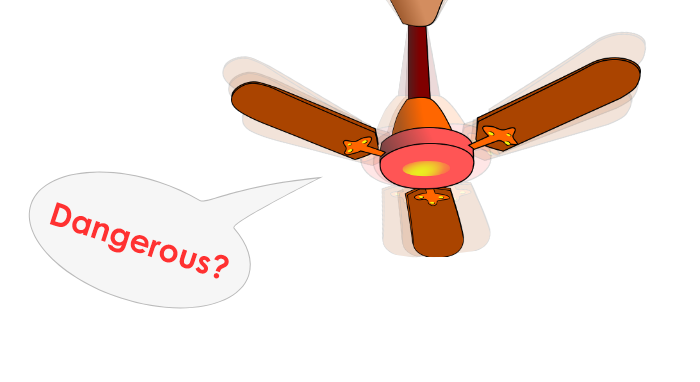
When you suddenly notice that your ceiling fan has started wobbling, you tend to ask yourself, “Is it dangerous? Like, are ceiling fans supposed to wobble?”. You are not alone. And that’s why we thought we’d shed some light on this.
Ceiling fans are not supposed to wobble, period. If yours does, then it’s either because it’s poorly made, incorrectly installed, or due to an underlying condition.
Ceiling fans usually wobble when –
- It’s not installed correctly
- The hanger ball becomes loose from its groove
- One or more blades or blade-irons bend (even slightly) or become loose
A wobbly ceiling fan is usually not very dangerous, but it certainly can be, especially if left unaddressed for a long time. It all depends on the cause of the wobble. If the wobble occurs due to a blade being slightly bent, you haven’t got much to worry about. But if it’s because a blade or the hanger ball has become loose, then you should be worried and try to fix it as soon as possible.
Check out this video from Home Depot on how to fix a wobbly ceiling fan:
How Safe Is It to Leave a Ceiling Fan on All Day?
A lot of people have great confusion as to what would happen if a ceiling fan is left running for a long time. Will it catch on fire? A lot of them tend to ask, “How long can a ceiling fan run continuously?”.
The reality is that ceiling fans are designed to operate for long hours without a pause, easily upwards of eight to ten hours. The idea that a ceiling fan will catch on fire due to friction and staff is very bogus. That is because, ceiling fans have very low RPM (not more than 150! Only!) which is not just enough to cause enough friction to cause a fire. Furthermore, they are designed to stay within a safe temperature limit. So, it’s not like the longer it runs the hotter it will get. And the cases of ceiling fans causing a fire that you might hear once in a blue moon are usually because of lack of maintenance, improper installation, or electrical shorts, and not because they were left running for long hours.
However, the point to be noted, ceiling fans don’t lower the ambient temperature of the room. Rather they just circulate the air around which makes you “feel” cooler. So, running a ceiling fan is only good as long as you are there. Leaving it running while you are not there has pretty much zero benefits. So, it’s always a good idea to give your fan some rest and save your electric bills.
Is It Safe to Leave a Ceiling Fan on When Leaving for a Long Time?
The answer to this question is the same as the one before. It is safe as long as you have a good quality fan, and you do maintenance on it regularly. However, why would you do that? There’s no benefit in doing that, as we have said already. And we don’t advise doing the same either, because, though very unlikely, if your ceiling fan goes wrong for some reason, you wouldn’t be there to control it until a major accident happens like a big fire breaking out and the whole house burned down. So, it is always better to give it some rest which will increase its longevity and save your wallet a bit, and perhaps the planet, too!
What Is a Safe Distance Between a Ceiling Fan Blade and a Wall?
When installing ceiling fans, you should keep a distance of at least 18 inches or more between the fan and the nearby walls, as recommended by EnergyStar. Technically speaking, even an inch is sufficient. However, for the fan to function properly, there has to be a generation of airflow going either upwards or downwards, and that needs space by the fan’s sides as there is no source of air from up top. Add to that the fact that when a fan starts to wobble, it needs more space than its blades dictate. So, a gap of 18 inches is a great recommendation.
Is the Electrical for a Ceiling Fan Dangerous to Work With?
It can be quite dangerous to work with ceiling fan electricals if you don’t know what you are doing. That is because proper installation is the key to ensuring a safe experience with ceiling fans, and there are many things that can go wrong if you are not competent enough to carry out the job. This includes identifying whether or not your ceiling fan box is not fan rated, knowing how to wire things properly, and also attaching each part with the others properly so that they won’t loosen up over time due to vibration. If any of these things go wrong, the result can be devastating.
However, if you are handy with electricity and know your staff well, you can approach a DIY ceiling fan installation with the help of the provided manual and the many how-to videos available online. For example, this one or the following one.
How Dangerous Is It to Mount a Fan to a Ceiling Box that Is Not Fan-Rated?
Installing a ceiling fan on a box that is not fan-rated can be extremely dangerous. A typical ceiling fan will weigh somewhere between 10 to 20 pounds. If your ceiling box is not rated to hold up that much weight, the fan is very likely to fall somewhere down the road. And while a ceiling fan fall (which happens very rarely) is usually not fatal, it can certainly be devastating to anyone or anything underneath it. So, install your ceiling fan only on ceiling-fan-rated boxes if you don’t want it to come flying down on your head like a crushing helicopter.
How to Ensure Ceiling Fan Safety
With all of these, here follow some of our guidelines on ensuring ceiling fan safety for you and your family.
1. Buy from a reliable brand
While you can certainly buy a cheaply manufactured non-brand phone for less than $100, the latest flagships from world-class brands would easily cost you way above $1000. There’s a reason why people still go for that extra zero for their daily driver – they are reliable. They deliver on their promises, at least most of the time.
The same goes for anything in life actually, including ceiling fans.
In the past, I used to be the kind of person who’d compromise on quality when making purchases to save a few bucks. But satisfaction would almost never accompany my purchases. So, I chose to be the opposite type of person. And now my life is much better.
So, do yourself a favor and spend a few more bucks if you need to, but make sure the fan you get is a quality one, preferably from a renowned brand. The extra dollars spent will prove their worth somewhere down the line, perhaps by preventing a fall that otherwise would have happened with a cheaply made fan.
2. Leave enough gap between the floor and the fan
I know this might not be as easy as it sounds for those who have a low ceiling. Nonetheless, you should still try to make sure that there’s enough space between your ceiling fan and floor so you can do your daily activities comfortably underneath. If you’ve got a low ceiling, you can go for a flush mount or hugger ceiling fan such as the Minka-Aire Concept II Model. EnergyStar recommends that you ensure a gap of at least 7 feet (preferably 8-9 feet) between your floor and ceiling fan. To quote,
“Ceiling fans should be installed, or mounted, in the middle of the room and at least 7 feet above the floor… If ceiling height allows, install the fan 8 – 9 feet above the floor for optimal airflow.”
EnergyStar
A good rule of thumb is, you should be able to raise your hand comfortably below your running ceiling fan without getting hit.
3. Position the fan away from bunk beds
As we have explained earlier in the bunk bed section, you should position your ceiling fans away from bunk beds. Children are curious about everything around them, and if it’s a rotating ceiling fan, don’t ask how much curiosity they have about these machines. Installing a ceiling fan within the reach of your kids can pose significant health risks to them in that they may try to reach for it and get hit or fall from the bed, resulting in serious injury.
So, keep ceiling fans away from beds.
Related: How to remove a ceiling fan
4. Don’t raise babies high when cuddling
In most cases, a ceiling fan won’t have much space between itself and the floor. The space usually is adequate to accommodate normal daily activities (like walking, lying, etc.). But in most cases, the space won’t be high enough to accommodate an adult and a baby raised high at the same time. And it’s no brainier that such an accident where the baby gets hit by the spinning blades could be extremely devastating, perhaps even fatal, since we are talking about babies with underdeveloped (soft) skulls. So, do yourself and your baby a favor – never raise them high below a running ceiling fan. This might take a while to develop the necessary subconscious alertness. But if you spend enough time on it, it sure is achievable.
5. Ensure proper installation
Ensuring proper installation of your ceiling fan is vital to ensure a safe experience throughout. If you are handy with ceiling fan installations, you can do it yourself. Otherwise, hire a pro to do the installation for you. It will be worth it in the long run. We’ve talked about this in more detail in our ceiling fan fall guide. Check that out if you need to.
6. Do proper maintenance
Though there’s not much maintenance needed for ceiling fans, you should still spend some time at least twice a year and check to see if your ceiling fans are in good health. If they need any maintenance, do so. Check this guide of ours for a more detailed explanation as to how you should go about doing maintenance on your ceiling fans.
Related: How To Clean Ceiling Fan Blades
So, Are Ceiling Fans Safe or Dangerous?
In conclusion, we say, ceiling fans are like any other appliance in the house. If you don’t know what you are doing, things can certainly go wrong. But if you take the necessary precautions, they are a very cost-effective AND safe option to get the much-needed comfortable breeze on the scorching hot days of summer. Remember, taking the necessary precautions is the key here. Imagine what can happen if a nuclear power plant goes wrong, and yet people have been safely generating very clean energy with nuclear fuel for decades now.
Lastly, I think it will be very helpful to check out the other benefits of ceiling fans! Find those here and here.
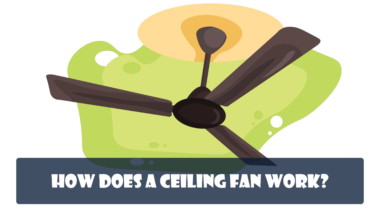
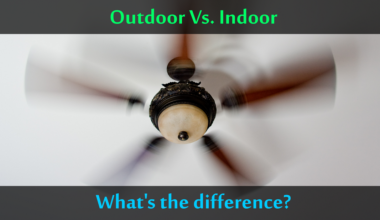





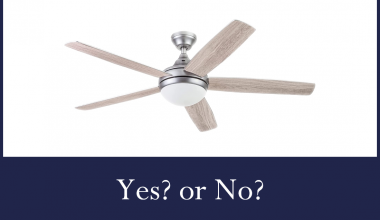
Conversation
No Comments here